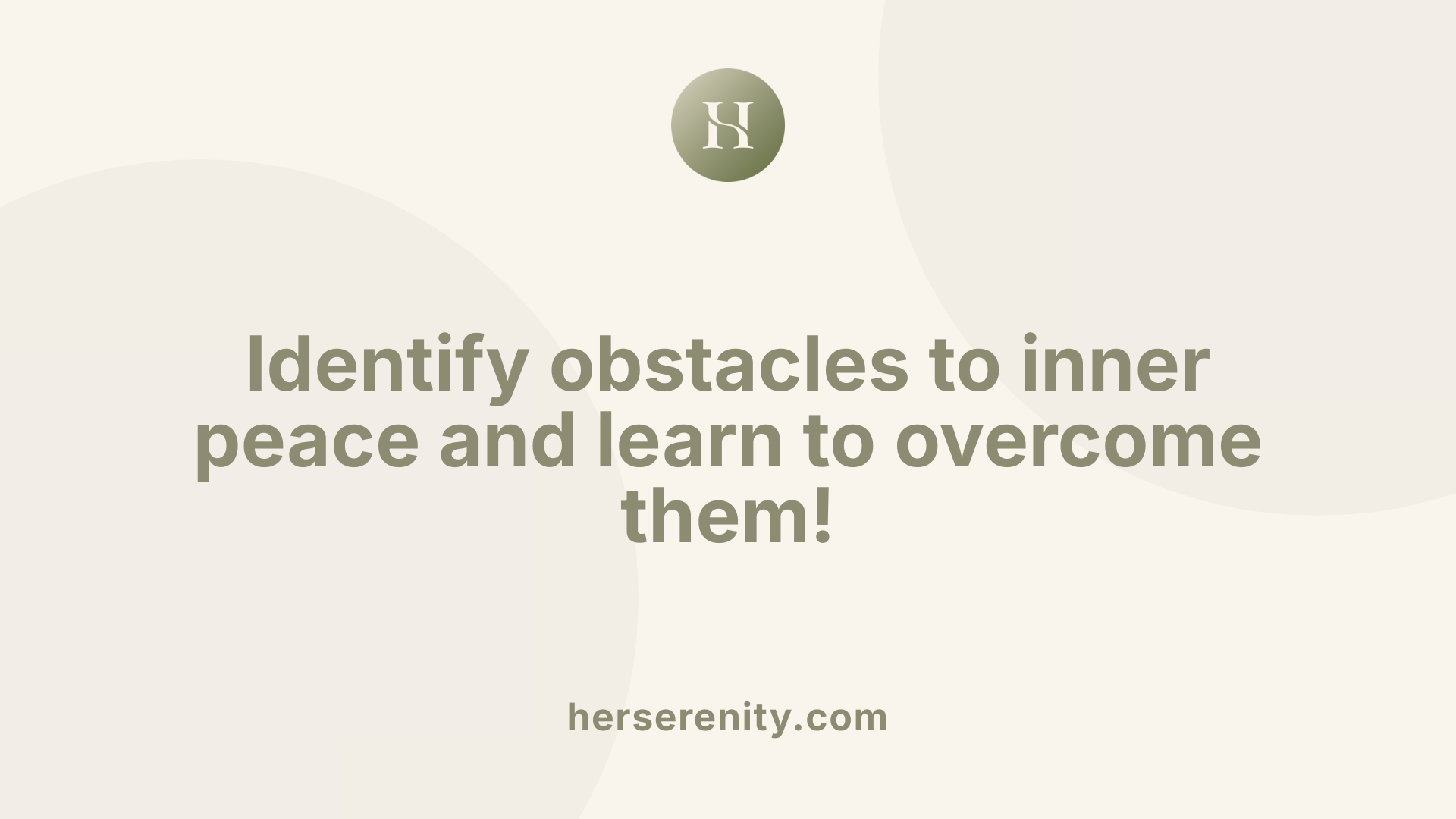The Role of Movement in Finding Inner Peace
Harnessing Movement for Serenity and Growth

Introduction
In today's fast-paced world, finding inner peace often seems like an elusive goal, yet many have discovered that the key lies in the art of movement. Practices such as yoga, tai chi, and even mindful walking not only help us maintain physical health but also contribute significantly to our mental and emotional well-being. By connecting body and mind through intentional movements, these disciplines promote mindfulness, emotional balance, and a profound sense of serenity.
The Power of Mindfulness in Yoga and Tai Chi

How do mindfulness practices like yoga and tai chi enhance inner peace and mental well-being?
Mindfulness practices like yoga and tai chi profoundly enhance inner peace and mental well-being by anchoring individuals in the present moment. This grounding fosters a sense of acceptance, both of oneself and the surrounding environment.
In yoga, the integration of breath with intentional movement creates a meditative experience that promotes relaxation and emotional regulation. As practitioners flow through postures, they cultivate self-awareness, developing a deeper connection with their bodies. This connection allows them to process emotions effectively, reinforcing a positive mindset.
Similarly, tai chi emphasizes slow, flowing movements that encourage mindfulness. As practitioners focus on their breath and body sensations, they enhance their awareness and promote tranquility. This discipline not only improves physical balance and flexibility but also nurtures psychological resilience.
Both practices incorporate elements of meditation and visualization, facilitating a greater sense of calm. For example, imagining serene landscapes can help deepen relaxation, providing a mental escape from daily stressors.
Ultimately, yoga and tai chi serve as vital self-care tools. They effectively reduce stress, improve emotional balance, and significantly enhance one's overall mental well-being, aligning the mind and body in harmonious coexistence.
Benefits of Mindfulness Practices
| Practice | Benefits | Techniques Used |
|---|---|---|
| Yoga | Improves flexibility, reduces anxiety | Breath control, meditation, movement |
| Tai Chi | Enhances balance, promotes relaxation | Slow movements, mindful breathing |
| Walking | Encourages observations, instills calmness | Sensory awareness, breath awareness |
By engaging in these mindful movement practices regularly, individuals can foster a tranquil life amidst external chaos.
Meditation: A Gateway to Inner Peace

How does meditation promote inner peace?
Meditation promotes inner peace by allowing individuals to focus their attention and clear their minds of distracting thoughts. This leads to a profound state of relaxation and mental clarity. Regular practice cultivates greater self-awareness and provides a fresh perspective on stressors, helping to reduce anxiety and enhance emotional well-being.
Different styles of meditation, such as mindfulness and guided imagery, create a tranquil environment conducive to balance and relaxation. Research supports the effectiveness of meditation, showing that it can significantly lower cortisol levels, which are responsible for stress. This reduction can have a remarkable impact on health, both mentally and physically.
Self-awareness and calming techniques
Engaging in meditation fosters self-awareness by enabling practitioners to observe their thoughts without judgment. This practice nurtures personal growth and self-acceptance. Techniques such as focused breathing and body scans not only ground individuals in the present moment but also enhance emotional regulation.
Reducing stress and anxiety
The direct benefits of meditation on stress and anxiety cannot be overstated. Regular practitioners often experience improved focus and cognitive abilities, along with enhanced emotional resilience. By cultivating a calm mind, individuals learn to navigate life’s challenges with greater ease, fostering a peaceful state of being.
Health benefits
Beyond mental well-being, meditation offers numerous health benefits. It contributes to improved mood, creativity, and physical vitality. Research has shown that meditation can lower blood pressure and improve sleep quality. By incorporating meditation into daily routines, individuals can foster a more balanced, peaceful, and enlightened existence.
| Benefit | Description | Impact on Well-Being |
|---|---|---|
| Reduces Stress | Lowers cortisol levels, leading to less tension | Enhances emotional health |
| Increases Self-Awareness | Improves understanding of personal thoughts | Encourages personal growth |
| Enhances Emotional Resilience | Develops coping mechanisms for stress factors | Improves overall mental health |
| Supports Physical Health | May lower blood pressure, improve sleep | Boosts energy levels |
Overcoming Barriers to Inner Peace

What are common obstacles to achieving inner peace and how can they be overcome?
Achieving inner peace is often obstructed by a range of challenges that can leave individuals feeling overwhelmed. Common barriers include:
- Insecurity: Doubts about oneself can create constant unrest in the mind.
- Social Media Comparison: Exposure to curated lives on social networks can lead to feelings of inadequacy.
- Resentment: Holding onto grudges can weigh heavily on emotional well-being.
- Emotional Impermanence: The transient nature of feelings can create confusion and tension.
To overcome these obstacles, fostering self-awareness is crucial. Engaging in practices like meditation and yoga helps cultivate a clearer understanding of one's emotions. Additionally, practicing forgiveness is essential to release resentment, allowing individuals to move forward.
Mindset and lifestyle adjustments
Shifts in mindset can significantly enhance the pursuit of inner peace. Adopting a positive outlook can be transformative, encouraging individuals to:
- Prioritize Health: Focus on sufficient sleep and nutrition to support emotional resilience.
- Engage with Nature: Spending time outdoors can uplift mood and reduce anxiety.
- Practice Gratitude: Regularly acknowledging what one is thankful for can increase overall happiness.
Supportive practices for tranquility
Complementing these mindset shifts with supportive practices can further facilitate a state of inner calm. Some effective strategies include:
- Mindfulness Activities: Engaging fully in daily tasks to transform routine into a moving meditation.
- Creative Self-Expression: Activities like dance and art provide emotional outlets, allowing for healing and growth.
- Seeking Professional Help: Therapy or counseling can offer additional support and strategies for managing deeper emotional challenges.
By incorporating these approaches, individuals can begin to dismantle the walls standing in the way of their inner peace, paving the path toward a more tranquil existence.
Exploring the Mind-Body Connection

What role does the mind-body connection play in emotional resilience and stress relief?
The mind-body connection plays a vital role in fostering emotional resilience and relieving stress. When individuals engage in holistic practices such as yoga, tai chi, and meditation, they create a harmonious relationship between their physical and mental well-being.
Practices like meditation are especially potent for stress relief. They encourage mindfulness, allowing individuals to deepen their self-awareness and manage stress effectively. For instance, meditation reduces negative emotions, lowers cortisol levels—the stress hormone—and enhances relaxation. Regular practice often leads to significant improvements in symptoms of anxiety, depression, and chronic pain, effectively bolstering emotional resilience.
Integration of body and mind
Integrating body and mind through movement-based practices enhances emotional health. Exercises like yoga and tai chi emphasize breath control and mindful movements, creating a dual focus that helps anchor thoughts and sensations in the present moment. This practice supports emotional stability and promotes a greater sense of inner peace.
Stress relief through movement
Movement serves as a powerful tool for stress relief. Engaging in activities like walking or dancing enables individuals to channel emotional energy rather than suppressing it, offering a significant boost to emotional regulation. By nurturing awareness of bodily sensations during movement, practitioners can release stored tensions and cultivate calmness, ultimately improving their ability to cope with life's challenges.
Movement as a Path to Personal Growth

How can movement practices contribute to self-expression and personal growth?
Movement practices like yoga, tai chi, and even dance play a vital role in fostering self-expression and personal growth. These activities enable individuals to forge a deeper connection between their body and mind, enhancing mindfulness that anchors them in the present moment. By focusing on movements, one can experience heightened awareness, leading to feelings of inner peace and balance.
Engaging in mindful movement facilitates self-love and acceptance. Individuals learn to appreciate both their strengths and areas of growth, enabling authentic self-expression. This process is particularly evident in dance, where physicality becomes a vessel for emotional release.
Moreover, incorporating mindful practices like walking and yoga into daily routines reduces stress, fostering an uplifting mindset that is crucial for personal development. The rhythm of movements in yoga flow or the gracefulness of tai chi promotes serenity, encouraging individuals to confront life's challenges with resilience and clarity.
Benefits of Integrating Movement in Daily Life
| Movement Practice | Benefits | Enhancements to Inner Peace |
|---|---|---|
| Yoga | Improves flexibility, reduces stress | Promotes calmness through breath control and meditation |
| Tai Chi | Enhances balance and mindfulness | Connects the body and mind, easing tension |
| Walking | Encourages sensory engagement | Acts as a moving meditation, grounding the practitioner |
Through these diverse movement forms, individuals nurture their bodies while simultaneously enriching their emotional landscapes, paving their journey toward personal growth.
Conclusion
The journey to inner peace is deeply personal and varied, yet embracing movement as an integral part of this journey can significantly enhance one's life. By integrating mindful practices like yoga, tai chi, and meditation into daily life, individuals foster a connection between mind and body, leading to greater emotional and mental well-being. These practices not only alleviate stress and anxiety but also open pathways for personal growth and self-expression, ultimately creating a more peaceful and fulfilling existence.
References
- Finding Peace in the Everyday Life: Finding Peace in Movement
- Peace Through Movement
- Inner Peace Through Movement: The Benefits of Tai Chi - Unity.org
- Meditation and Mindfulness: Finding Inner Peace Through Movement
- Harmony in the mind-body connection for inner peace - LYT Yoga
- Walking Towards Inner Peace - Utrecht - Yoga Moves
- Mindful Movement: Finding Inner Peace in the Gym | Active Jersey
- Emotional Grounding: Powerful Movement Practices to Unlock ...
- Finding Inner Peace Through Yoga Practice - Omstars
- A Way to Inner Peace through Outer Expression - Nina Wise

































































































